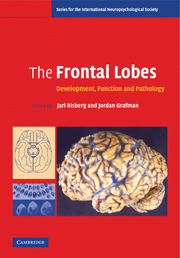Book contents
- Frontmatter
- Contents
- Contributors
- From the series editor
- Introduction
- 1 Evolutionary aspects on the frontal lobes
- 2 Organization of the principal pathways of prefrontal lateral, medial, and orbitofrontal cortices in primates and implications for their collaborative interaction in executive functions
- 3 Human prefrontal cortex: processes and representations
- 4 A microcircuit model of prefrontal functions: ying and yang of reverberatory neurodynamics in cognition
- 5 Prefrontal cortex: typical and atypical development
- 6 Case studies of focal prefrontal lesions in man
- 7 Left prefrontal function and semantic organization during encoding and retrieval in healthy and psychiatric populations
- 8 Clinical symptoms and neuropathology in organic dementing disorders affecting the frontal lobes
- Index
- Plate section
- References
8 - Clinical symptoms and neuropathology in organic dementing disorders affecting the frontal lobes
Published online by Cambridge University Press: 11 September 2009
- Frontmatter
- Contents
- Contributors
- From the series editor
- Introduction
- 1 Evolutionary aspects on the frontal lobes
- 2 Organization of the principal pathways of prefrontal lateral, medial, and orbitofrontal cortices in primates and implications for their collaborative interaction in executive functions
- 3 Human prefrontal cortex: processes and representations
- 4 A microcircuit model of prefrontal functions: ying and yang of reverberatory neurodynamics in cognition
- 5 Prefrontal cortex: typical and atypical development
- 6 Case studies of focal prefrontal lesions in man
- 7 Left prefrontal function and semantic organization during encoding and retrieval in healthy and psychiatric populations
- 8 Clinical symptoms and neuropathology in organic dementing disorders affecting the frontal lobes
- Index
- Plate section
- References
Summary
Introduction
Historically the clinical importance of localized cortical atrophy within the frontal and the temporal lobes was first described by Arnold Pick, who pointed out the relationship between these lesions and aphasia and behavioral changes, “thereby bringing neuropathology and psychiatry into closer union … so that the latter may be brought nearer to understanding” (Pick, 1892). Pick's first cases showed mainly temporal lobe involvement and the association with frontal lobe atrophy appeared in later publications. The histopathology of this lobar atrophy was given by Alzheimer (1911) and the clinico-pathological entity of Pick's disease (PiD) was established in the 1920s (Onari & Spatz, 1926; Stertz, 1926). Van Mansvelt (1954) reviewed 196 published cases and found an important variation of the distribution of pathology with frontotemporal atrophy in 54%, mainly frontal atrophy in 25% and mainly temporal atrophy in 17% of the cases. Moreover, the cortical atrophy was asymmetric with left-sided predominance in 46% and right-sided predominance in 17%. The different degenerative patterns were also revealed as variations of the clinical manifestations. Since then there has been an increasing interest in brain disorders specifically affecting the frontal lobes and their often devastating effects on a variety of mental functions.
In this chapter we will first discuss some possible explanations why the frontal lobes are such frequent targets for a variety of damaging processes. After that some general mechanisms of importance for understanding the relationship between symptoms and brain changes will be described.
- Type
- Chapter
- Information
- The Frontal LobesDevelopment, Function and Pathology, pp. 199 - 221Publisher: Cambridge University PressPrint publication year: 2006



